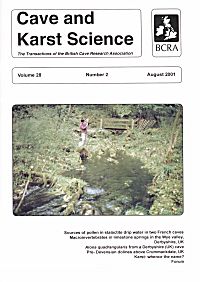
BCRA > Publications > Cave & Karst Science> Contents
Scroll down for Editorial | Papers | Reports | Forum | Thesis Abstracts
 |
Cover Photo by John Gunn of Wormhill Spring, Derbyshire, UK. Wormhill Spring is the largest of over 20 limestone springs that supplement the flow of the River Wye, the only river to maintain a perennial flow across the northern 'White Peak' district of Derbyshire. The springs have a diverse aquatic ecology, as discussed in the article by Smith et al. in this Issue. |
The editorial comments on the difficulties encountered in the etymological refereeing of the report on the origin of the word "karst" in this Issue, and on problems with the production of the diacritical marks required .
At the recent BCRA AGM in Buxton there was some comment to the effect that it is 'too difficult' for the 'average caver' to prepare an article to the high standard expected by Cave and Karst Science referees. It is hoped that the tribulations recorded in the earlier part of the Editorial about the karst report will serve to illustrate the Editors' commitment and desire, both to maintain high standards, and to assist contributors in achieving them to the best of the Editors' ability.
Vol 28 (2) pp 94 - 96
This page created by j.wilcock[at]bcra..., and edited by David Gibson.